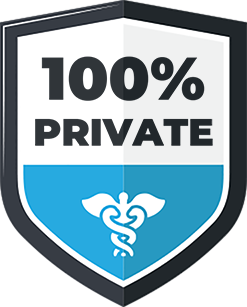Chlamydia is caused by the Chlamydia trachomatis bacterium, a bacterium that can spread through the sharing of sexual fluids, typically through anal, oral, or vaginal sex. Both men and women are susceptible to chlamydia infections.
Chlamydia and Gonorrhea Panel
- Secure and Confidential Results
- Over 4,500 CLIA-Certified Labs U.S. Labs
- Most Results in 1-3 Days
- 110% Price Guarantee
About Our Chlamydia and Gonorrhea Panel
Chlamydia and gonorrhea are two of the most common and fast-spreading sexually transmitted infections (STIs) in the United States. Both are:
- Highly prevalent
- Usually symptom-free
- Easily spread
- Caused by bacteria
Because symptoms are often absent, many people who are infected don’t realize it. The CDC estimates over 3 million chlamydia infections occur each year, and gonorrhea rates have been rising sharply, especially as certain strains become more resistant to antibiotics.
Why Test for Both?
Chlamydia and gonorrhea frequently occur together, and having one increases your likelihood of having the other. They also share similar symptoms when symptoms do appear.
Testing for both infections at the same time ensures:
- More accurate diagnosis
- Faster treatment
- Reduced risk of complications
- Protection for current and future partners
That’s why healthcare providers recommend testing, and treating, both infections together.
How We Test for Chlamydia & Gonorrhea:
We use the FDA-approved nucleic acid amplification test (NAAT), the gold standard for detecting these infections.
This test:
- Uses a simple urine sample
- Identifies the DNA of Chlamydia trachomatis and Neisseria gonorrhoeae
- Detects active, current infections
If the bacteria’s genetic material is found, it confirms an active infection that requires treatment.
Are They Curable?
Yes! Both chlamydia and gonorrhea are 100% curable with the right antibiotics. With proper treatment, most people recover quickly.
Can I Get Reinfected?
Yes. Even after successful treatment, you can be reinfected if you’re exposed again. That's why routine testing after new sexual encounters is so important.
Who Should Consider This Panel?
You may benefit from this test if:
- You have had multiple or new sexual partners
- You are entering a new relationship and both partners want a comprehensive check
- You have had unprotected sex and want broad testing in one visit
- You want STD screenings without scheduling a doctor’s visit first
110% Price Guarantee!
If you find the same test for a lower price from a comparable provider, contact us. We not only match the price, we beat it by an additional 10 percent of the difference.
Common Questions:
-
What Causes Chlamydia?
-
What are Chlamydia Symptoms?
Chlamydia is often asymptomatic, meaning it doesn’t produce any symptoms. However, if symptoms do occur, they can include:
- Painful urination
- Itching and burning in/around the vagina or penis
- Bleeding between periods/painful periods
- Women may experience pain during intercourse
- Small amounts of clear/cloudy discharge from the penis
- Abnormal vaginal discharge (may have an odor)
- Premature childbirth
-
What happens when Chlamydia is left Untreated?
If chlamydia goes untreated, it can lead to infertility, pelvic inflammatory disease (PID), and ectopic pregnancy in women. For men, untreated chlamydia can cause Nongonococcal urethritis (NGU) and damage to the reproductive tract.
-
What causes Gonorrhea?
Gonorrhea is caused by the bacteria Neisseria gonorrhoeae. This bacteria is spread through the exchange of sexual fluids, most often through vaginal, anal, and oral sex.
-
What are the symptoms of Gonorrhea?
Gonorrhea often does not produce any symptoms. However, if symptoms occur, they can include the following:
- Greenish, yellow, or white vaginal discharge
- Conjunctivitis (pink eye)
- Burning during urination
- Lower abdominal pain/pelvic pain
- Swelling of the vulva
- Bleeding between periods or spotting after intercourse
- Burning in the throat (from oral sex)
- Painful or swollen testicles
- Swollen glands in the throat (from oral sex)
-
What Happens when Gonorrhea is left Untreated?
Untreated gonorrhea can lead to ectopic pregnancy or pelvic inflammatory disease (PID) in women, which can cause infertility. In men, untreated gonorrhea can cause urethral scarring and epididymitis, a painful testicular condition that can affect fertility. If gonorrhea spreads to the joints or blood, it can be deadly.
-
Do I need to fast before this test?
Fasting is not required for this panel. You can eat and drink normally unless your doctor has given you other instructions.
-
Will anyone see my results besides me?
Your results are stored in your secure online account. They are not shared with anyone else. If you choose, you can print or download them to share with your own doctor.
-
Can I talk to someone about my results?
Yes. If your results come back positive or if you simply have questions, our team is here to support you. You can text our Patient Services team at 1800-579-3914, anytime between 8am and 8pm.
If you need prescription treatment, you can request it directly through your online account or by contacting our support team as well. They will help coordinate a consultation with a clinician so you can get the care you need quickly and discreetly.
-
Can I use insurance to pay for this test?
In order to ensure your privacy, we do not bill insurance directly, but you may use HSA or FSA funds. This keeps your results and testing completely private from insurers. We can also provide you with an itemized receipt for insurance reimbursement purposes if you need it.













